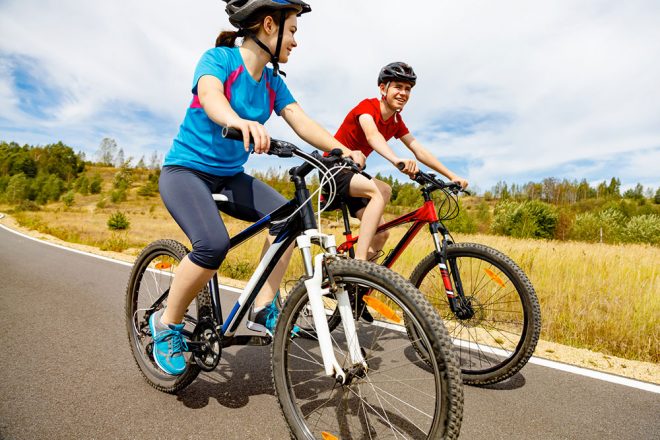Originally posted by the Alberta College and Association of Chiropractors
Cycling in Alberta has seen a spike in popularity, trading in the car for a bicycle has become more commonplace than ever. Some cyclists strap on their helmets and ride for exercise or enjoyment while others view cycling as a way to protect the environment from unnecessary emissions.
Although cycling has many benefits, cyclists can be at risk of injury from their sport. The repetitive nature of riding a bike can cause problems with both muscles and joints due to overtraining, poor form, poorly fit bike, or many other factors.
Common biking Injuries and how to prevent them
Lower back pain
Lower Back pain (LBP) can cause problem for cyclists for a number of reasons. The easiest explanation is the prolonged bending of the back. It doesn’t take a Musculoskeletal (MSK) expert to see that cyclists spend long periods of time in a fixed position. A poorly fit bike or bad body position on the bike can lead to lower back pain due to abnormal wear to the joints along your spine as well a number of muscular imbalances.
How to prevent LBP – There are a few tools you can use to help fight lower back pain while you hit the road on your bike.
Form – As with anything to do with the spine, posture is important. While riding, keep a neutral spine by bending at the hips and avoid hunching your mid-back. Your spine naturally has a curve to it, this should be maintained while riding but not overemphasized or flattened. It is often difficult to evaluate your own posture so it is worth having someone look at your body position on your bike or use a trainer in front of a mirror.
Equipment – A poorly fit bike may also be the cause of your LBP, being either too stretched out or compacted by your bike can result in abnormal stresses to your back. Most local bike shops have trained staff that can assist you with ensuring your bike is the correct size for you as well as any minor adjustments required to fit the bike to your body.
Knee pain
Pain in your knees can be caused by several factors, most commonly it is due to poorly adjusted cleats or pedals forcing your feet out of alignment with your knees however improper seat height, prior knee injuries, poor cycling form, muscle imbalance or overtraining can cause knee pain.
How to prevent knee pain – There are a few things to look for when trying to determine the cause of your knee pain.
Pedals/Cleats – How your feet sit on the pedals could be the key to preventing your knee pain, especially if you are using clipless pedals that lock your feet in place. Your knee should be pointing straight ahead and your feet should be parallel to the ground while you are pedaling. Riders often have a tendency to tilt their knees out.
Seat Height – A seat height that is either too high or too low will cause stress on the knees. Too high and you will be hyperextending the knee on every pedal stroke and too low causes a loss in power and excessive load to the knees. Ideally, your knee should be slightly bent (not locked) at the bottom of your pedal stroke with your feet parallel to the ground.
Prior Injury
If you have had a prior injury to your knee, hip or ankles your seat height, pedal positioning and other bio-mechanics will need to adapt. If you have been cleared by a health care professional (such as your chiropractor)l to ride it is a good idea to get an assessment from a qualified bike fitter to ensure you are not causing re-injury.
Muscle Imbalance or overtraining
Muscle imbalance is quite common in cyclists since certain muscles will be strengthened by the exercise while other supporting musculature may not. It is a good idea to find an exercise to strengthen the stabilizing muscles in your leg to maintain balance. For beginner riders it is important to start out slow and not seek massive gains in distance, speed, time or effort too quickly. Your body will need time to adjust to a change in activity.
Shoulder Pain
Pain in your shoulders while riding can be caused by carrying stress in your shoulders while riding, poor body position on the bike or a poorly fit bike.
Wrist Pain
The most common cause of wrist pain is a very aggressive cycling position that causes you to put a lot weight on your handlebars. Try to move your hand position around on your handlebars as much as possible to avoid the same position for extended periods of time.
Visit your Chiropractor
If you’re thinking about taking up cycling talk to your chiropractor before you strap on the helmet and hit the road. Together you will be able to identify potential injury concerns and ensure you get off to an injury free start. If you are experiencing pain, numbness or tingling or other MSK problems while riding your chiropractor will also be able to provide treatment and advice to treat these problems.
For more blogs and information like this, follow us on Twitter or like us on Facebook.

